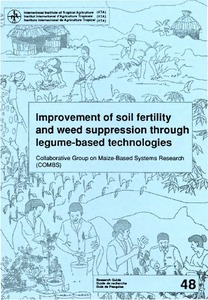| dc.contributor.author | Nielsen, S. |
| dc.contributor.author | Brandt, W. |
| dc.contributor.author | Singh, B. |
| dc.date.accessioned | 2019-12-04T11:26:19Z |
| dc.date.available | 2019-12-04T11:26:19Z |
| dc.date.issued | 1993 |
| dc.identifier.citation | Nielsen, S., Brandt, W. & Singh, B. (1993). Genetic variability for nutritional composition and cooking time of improved cowpea lines. Crop Science, 33(3), 469-472. |
| dc.identifier.issn | 0011-183X |
| dc.identifier.uri | https://hdl.handle.net/20.500.12478/4537 |
| dc.description.abstract | Cowpea, Vigna unguiculata (L.) Walp., is a major source of dietary protein in sub-Sahara Africa, Asia, and Latin America. Current breeding objectives are disease and insect resistance and high yield potential, but efforts are being made to initiate a selection program to improve protein content and cooking quality. This study was undertaken to estimate variability for protein content and cooking quality in 100 improved cowpea breeding lines grown in the field at Ibadan, Nigeria in 1986. Moisture, protein, fat, and ash content were determined by standard methods. Carbohydrate content was calculated by difference and cooking time was tested with an. automated Mattson-type bean cooker. Genetic variability was observed for all traits. The values, on a dry weight basis, ranged from 22.9 to 32.5% for protein, 2.9 to 3.9% for ash, 1.4 to 2.7% for fat, 59.7 to 71.6% for carbohydrate, and 21.1 to 61.9 minutes for 50% cooking time. The breeding line IT83S-872 had the highest protein content, 1T85F-2805 and IT8SF- 1380 had the highest fat content, IT84S-2085 and IT86D-466 had the highest ash content, IT86D-463-1 had the lowest carbohydrate, and IT85F-2805 had the shortest cooking time. Protein content was positively correlated with ash content, but negatively correlated with fat and carbohydrate contents. Carbohydrate content was negatively correlated with ash content. Small seed size and rough seed coat were associated with shorter cooking time. Results indicated significant genetic variability for protein content and cooking time, which can be exploited in a breeding program to develop nutritionally superior and acceptable cowpea cultivars. |
| dc.language.iso | en |
| dc.subject | Proteins |
| dc.subject | Breeding Lines |
| dc.subject | Carbohydrates |
| dc.subject | Genetic Variability |
| dc.title | Genetic variability for nutritional composition and cooking time of improved cowpea lines |
| dc.type | Journal Article |
| dc.description.version | Peer Review |
| cg.contributor.affiliation | International Institute of Tropical Agriculture |
| cg.contributor.affiliation | Purdue University |
| cg.coverage.region | Africa |
| cg.coverage.region | Acp |
| cg.coverage.region | West Africa |
| cg.coverage.region | North America |
| cg.coverage.country | Nigeria |
| cg.coverage.country | United States |
| cg.isijournal | ISI Journal |
| cg.authorship.types | CGIAR and advanced research institute |
| cg.iitasubject | Food Science |
| cg.iitasubject | Food Systems |
| cg.iitasubject | Plant Breeding |
| cg.iitasubject | Cowpea |
| cg.iitasubject | Genetic Improvement |
| cg.accessibilitystatus | Limited Access |
| local.dspaceid | 100787 |
| cg.identifier.doi | https://doi.org/10.2135/cropsci1993.0011183X003300030010x |

